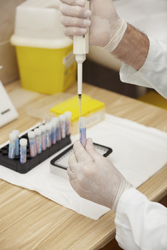Novel bioassay system
Antibodies do not function well in microarray detection systems. The majority of antibody assays instead rely on a sandwich format with a secondary labelled antibody. However, this approach is time-consuming and gives high background signal. To overcome these non-specificity limitations, scientists of the EU-funded MPKADAIC project looked for alternative systems. They proposed to explore the electrical parameters — impedance and capacitance to develop electrical-based protein detection assays. To this end, they immobilised antibodies for insulin, C-reactive protein (CRP) and alpha-synuclein on gold electrodes. Upon binding with their target molecule, the resultant protein biosensors caused significant electrical impedance changes, which were monitored using Faradaic electrochemical impedance spectroscopy. These assays exhibited great selectivity due to the highly specific nature of the antibody-protein binding and the reduced non-specific adsorption capacity of the electrodes. Additionally, they proved extremely sensitive, demonstrating a detection capacity at the picomolar range. The accumulation of microorganisms on the sensors – referred to as biofouling – is an undesirable side effect. Scientists resorted to zwitterionic polymer or polyethelene glycol to coat the electrodes to minimise biofouling. Both of these compounds demonstrated excellent antifouling properties while maintaining their antibody binding efficacy. Combined systems using microelectrodes were designed to detect insulin and CRP simultaneously in real human serum samples. The detection sensitivity of this system was within national health service standards while its measurements demonstrated an 80 % reliability. Such multiplexed assays are of great significance for the diagnosis of complex diseases that require measurement of multiple protein biomarkers to ensure diagnostic reliability. Having overcome obstacles such as low efficiency, unreliability and biofouling, the MPKADAIC protein detection systems could be used for point-of-care disease diagnosis.







